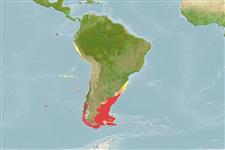Polyplacophora |
Lepidopleurida |
Leptochitonidae
Environment: milieu / climate zone / Mức độ sâu / distribution range
Sinh thái học
; Mức độ sâu 0 - 300 m (Tài liệu tham khảo 87801). Temperate
Southeast Pacific: Argentina and Chile.
Length at first maturity / Bộ gần gũi / Weight / Age
Chín muồi sinh dục: Lm ? range ? - ? cm Max length : 1.0 cm TL con đực/không giới tính; (Tài liệu tham khảo 1875)
Length based on occurrence record; to be replaced with better reference. Known from the intertidal areas to a depth of 300 m. They are found on hard substrates including holdfasts of Macrocystis sp., cobbles, pebbles, and shells lying on silt, under boulders or buried in sand (Ref. 87801).
Life cycle and mating behavior
Chín muồi sinh dục | Sự tái sinh sản | Đẻ trứng | Eggs | Sự sinh sản | Larvae
Members of the class Polyplacophora are mostly gonochoric. Life cycle: Eggs hatch into lecitotrophic planktonic trocophore larvae (no veliger stage) which later metamorphose and settle on the bottom as young adults.
Kaas, P. and R.A. van Belle 1985 Monograph of the Living chitons (Mollusca: Polyplacophora). Vol.1. Order Neoloricata: Lepidopleurina. E.J. Brill publishers, Leiden. 240 p. (Tài liệu tham khảo 1875)
IUCN Red List Status
(Tài liệu tham khảo 130435: Version 2025-1)
CITES status (Tài liệu tham khảo 108899)
Not Evaluated
CMS (Tài liệu tham khảo 116361)
Not Evaluated
Threat to humans
Harmless
Human uses
| FishSource |
Các công cụ
Thêm thông tin
Sinh thái dinh dưỡngFood items (preys)
Thành phần thức ăn
Thành phần thức ăn
Các động vật ăn mồi
Population dynamicsSự sinh trưởngMax. ages / sizesLength-weight rel.Length-length rel.Length-frequenciesMass conversionSự phong phú Life cycleSự tái sinh sảnChín muồi sinh dụcSự sinh sảnĐẻ trứngEggsEgg developmentLarvae PhysiologyThành phần ô-xy
Human RelatedStamps, coins, misc.
Các nguồn internet
Estimates based on models
Preferred temperature
(Ref.
115969): 5.1 - 12.3, mean 7.5 (based on 383 cells).
Fishing Vulnerability
Low vulnerability (10 of 100).
